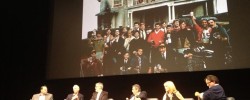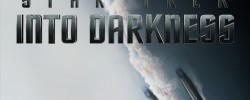
Review: Berberian Sound Studio (2012)

Cast: Toby Jones, Susanna Cappellaro, Antonio Mancino
Director: Peter Strickland
Country: UK
Genre: Drama | Horror | Thriller
Official Trailer: Here
Editor’s Note: Berberian Sound Studio opens tomorrow, June 14th in limited theatrical release and on VOD. For an alternate take on the film, see Jacqueline’s review.
“All this filming isn’t healthy,” warned Mrs. Stephens in Peeping Tom, wary of the eponymous antihero’s fascination with the filmed image and its voyeuristic capabilities. She, of course, was a blind woman, herself unable to experience the disconcerting effect of the screen’s relation to the real world. But cinema is more than mere image, and since the advent of sound in 1927 what we hear has been every bit as instrumental to movies’ effect as what we see. We don’t see much in Berberian Sound Studio, Peter Strickland’s detail-soaked homage to Italian gialli; instead, we are made privy to the peculiarities of sound as meek English foley artist Gilderoy crafts the brutal soundscape to one such blood-soaked ‘70s horror.
Toby Jones loses himself in the lead role, putting his unique face to extraordinary use as a mirror reflection of the horrors unfolding onscreen. He makes of himself not just a capable anchor to the film, but a powerful engine too, propelling it forward with all the reckonable momentum of his reactionary performance…
 It’s a brilliant conceit on Strickland’s part, restricting the film-within-the-film to the frightening realms only the human imagination can concoct, and thus focusing our attention on the way in which sound plays upon our minds. Just as Peeping Tom’s silent film-within-a-film footage emphasised the importance of image, Berberian Sound Studio accentuates the eccentricities of sound; we all know the classic foley tricks—be it paper pulled from an envelope for Star Wars’ spaceship doors or coconut shells clicked together for horse hooves—but Strickland’s isolation of such tricks from their associated images begs us to question what these abstractions do to the mind: in knowing that it is not a human body thrown from a window we hear, but rather simply a marrow dropped from the arms, are we divorced from the reality of pain and suffering?
It’s a brilliant conceit on Strickland’s part, restricting the film-within-the-film to the frightening realms only the human imagination can concoct, and thus focusing our attention on the way in which sound plays upon our minds. Just as Peeping Tom’s silent film-within-a-film footage emphasised the importance of image, Berberian Sound Studio accentuates the eccentricities of sound; we all know the classic foley tricks—be it paper pulled from an envelope for Star Wars’ spaceship doors or coconut shells clicked together for horse hooves—but Strickland’s isolation of such tricks from their associated images begs us to question what these abstractions do to the mind: in knowing that it is not a human body thrown from a window we hear, but rather simply a marrow dropped from the arms, are we divorced from the reality of pain and suffering?
Acting as audience surrogate in every sense of the word, alien in both the genre of filmmaking and country where he finds himself working, Gilderoy’s evolution in the course of the film tells us more about the impact of this line of work than simply showing the images themselves ever would. Too often cast only in supporting parts, where he reliably steals the spotlight from his fellow performers, Toby Jones loses himself in the lead role, putting his unique face to extraordinary use as a mirror reflection of the horrors unfolding onscreen. He makes of himself not just a capable anchor to the film, but a powerful engine too, propelling it forward with all the reckonable momentum of his reactionary performance and refusing to allow the immersive atmosphere that defines the film be wounded by the few pacing issues to which Strickland falls victim.
It’s as disturbing as it is dementedly brilliant when the third act, which gradually moves from the firm ground of narrative causality toward the altogether more haunting territory of expressive oddity, repeats that same dissociation upon us, expanding the horror to three tiers of inextricable effect.
 And what an atmosphere it is: horror, as so few modern movies seem to realise, is not the surprise of a sudden loud noise, but the terror of being made to feel part of an oppressive environment. That’s precisely what happens to Gilderoy in the course of the narrative, his growing dissociation from reality casting him in that purgatorial space between the real world and the reel world. With cinematographer Nicholas D. Knowland, Strickland frames Jones’ face impeccably, capturing the minutiae of terror as disgust and distress turn first to horrified curiosity, then to grim intrigue. It’s as disturbing as it is dementedly brilliant when the third act, which gradually moves from the firm ground of narrative causality toward the altogether more haunting territory of expressive oddity, repeats that same dissociation upon us, expanding the horror to three tiers of inextricable effect.
And what an atmosphere it is: horror, as so few modern movies seem to realise, is not the surprise of a sudden loud noise, but the terror of being made to feel part of an oppressive environment. That’s precisely what happens to Gilderoy in the course of the narrative, his growing dissociation from reality casting him in that purgatorial space between the real world and the reel world. With cinematographer Nicholas D. Knowland, Strickland frames Jones’ face impeccably, capturing the minutiae of terror as disgust and distress turn first to horrified curiosity, then to grim intrigue. It’s as disturbing as it is dementedly brilliant when the third act, which gradually moves from the firm ground of narrative causality toward the altogether more haunting territory of expressive oddity, repeats that same dissociation upon us, expanding the horror to three tiers of inextricable effect.
Its uncanny ability to put its audience through the very emotional and mental turmoil of its protagonist is the root of Berberian Sound Studio’s remarkably cineliterate power. From the opening chords’ shades of The Wicker Man to the wealth of giallo references it knowingly boasts, this is a movie as interested in working with horror tropes as it is in dissecting why they work, and what knowing how they work does to us. Gorgeously recreating the world of its setting, and employing every vagrant nuance of its crew’s filmmaking savvy, it immerses us in one world itself immersed in another. “All this filming isn’t healthy,” warned Mrs. Stephens. All this filming about filming, somehow, is strangely wholesome.
Related Posts
![]()
Ronan Doyle
![]()
Latest posts by Ronan Doyle (see all)































